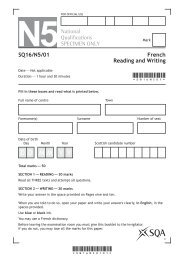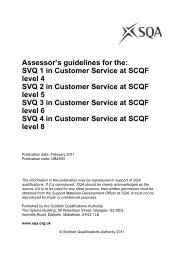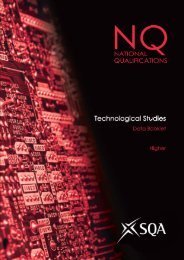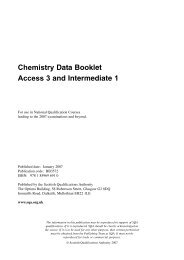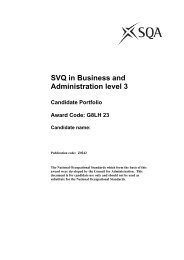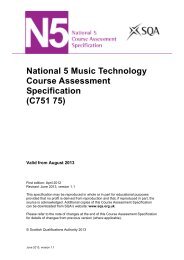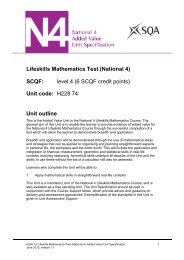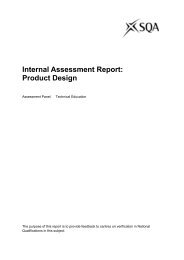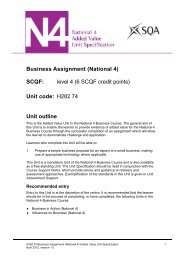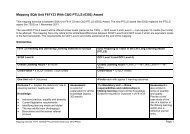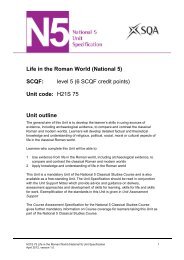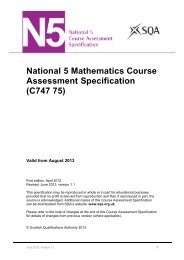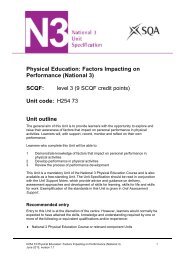Core Skills Numeracy - Scottish Qualifications Authority
Core Skills Numeracy - Scottish Qualifications Authority
Core Skills Numeracy - Scottish Qualifications Authority
Create successful ePaper yourself
Turn your PDF publications into a flip-book with our unique Google optimized e-Paper software.
Higher National and Vocational <strong>Qualifications</strong><br />
Internal Assessment Report 2012<br />
<strong>Core</strong> <strong>Skills</strong> <strong>Numeracy</strong><br />
The purpose of this report is to provide feedback to centres on verification in<br />
Higher National and <strong>Scottish</strong> Vocational <strong>Qualifications</strong> in this subject.<br />
1
SVQ awards<br />
F42904 — <strong>Numeracy</strong>, SCQF level 3<br />
F42A04 — <strong>Numeracy</strong>, SCQF level 4<br />
F42B04 — <strong>Numeracy</strong>, SCQF level 5<br />
F42C04 — <strong>Numeracy</strong>, SCQF level 6<br />
General comments<br />
The verifiers’ reports indicated that in all of the centres visited there was a clear<br />
understanding of the requirements of the National Standards.<br />
In the majority of cases, centres had an induction policy, including specific<br />
induction for assessors and Internal Verifiers. The roles and responsibilities for<br />
new assessors and verifiers were clearly stated, as were the requirements of the<br />
National Standards.<br />
Evidence from reports suggested that all assessors are familiar with the range of<br />
documentation and are fully supported by effective internal verification<br />
processes. All assessors and Internal Verifiers had the appropriate training<br />
qualification, or were working towards it.<br />
New assessors went through a robust induction process to ensure they were<br />
competent to carry out their role. The Internal Verifiers were closely involved in<br />
the induction and training of new assessors.<br />
All centres have quality assurance systems to ensure standards are maintained.<br />
This was generally co-ordinated by an SQA contact with responsibility for the<br />
dissemination of information from SQA, staff induction and training in SQA<br />
procedures, CPD activities, co-ordination of internal and external verification, and<br />
auditing of SQA processes.<br />
In most cases, master files are available containing comprehensive information<br />
relating to the systems and procedures for the delivery and quality assurance of<br />
the award.<br />
There was clear evidence that assessors and candidates were involved in<br />
planning and reviewing assessments. The candidates maintained a portfolio and<br />
identified tasks and activities which could be used to produce evidence. The<br />
assessor would then provide assessments that filled the gaps in this naturally<br />
occurring evidence.<br />
Documentation was presented in a clear and concise form that assisted the<br />
verification process.<br />
2
Unit specification, instruments of assessment and<br />
exemplification materials<br />
It was apparent from the external verification reports that assessors and Internal<br />
Verifiers were familiar with the Unit specifications and Assessment Support<br />
Packs.<br />
The Assessment Support Packs were often used to provide information on the<br />
delivery of the Units and to provide guidance on assessment and Evidence<br />
Requirements.<br />
The level and amount of evidence required was discussed at standardisation<br />
meetings.<br />
Most centres produced student portfolios of evidence that were cross-referenced<br />
with the assessment checklist. Assessors and candidates discussed the<br />
assessment requirements, and the portfolios allowed the candidates to identify<br />
where assessment evidence could be obtained.<br />
Assessment decisions were consistent, both within centres and across the<br />
centres visited.<br />
Evidence Requirements<br />
Assessors discussed with candidates the evidence required for the Unit.<br />
Candidates were often encouraged to take ownership of the Unit and to identify<br />
evidence from their workplace. Where no naturally generated evidence was<br />
available, examples from the Assessment Support Packs were used as models<br />
to develop contextualised tasks at the appropriate level.<br />
Most centres made effective use of checklists to ensure that the source of<br />
evidence could be clearly identified. Regular internal verification checks ensured<br />
that the level and amount of evidence was appropriate.<br />
In all centres visited, regular standardisation meetings were held to ensure that<br />
issues such as the level and the amount of evidence required could be discussed<br />
and agreed.<br />
In many centres, all candidates’ evidence was internally verified.<br />
Administration of assessments<br />
Centres make full use of the information provided in the Unit specification and<br />
Assessment Support Packs to ensure that assessments are at the appropriate<br />
level.<br />
Most centres make use of portfolios to plan and review progress.<br />
Where evidence was produced in the workplace without the assessor being<br />
present, witness testimony was used to verify the assessment.<br />
3
Methods of assessment were valid, reliable and practical.<br />
Internal verification procedures were reviewed on a regular basis, usually at least<br />
annually. Comments from internal verifiers were helpful and supportive. Internal<br />
verification procedures were robust and effective.<br />
General feedback<br />
In the majority of cases, candidates were involved in planning their assessment<br />
and took responsibility for identifying situations they encountered in the<br />
workplace where evidence could be generated.<br />
Candidates discussed the relevance of <strong>Core</strong> <strong>Skills</strong> and how they could be useful<br />
in everyday situations.<br />
In all cases, candidates had ready access to assessments and were in regular<br />
contact with the assessor.<br />
Areas of good practice<br />
All reports commented on the effective organisation of the centres and on the<br />
clarity and quality of the documentation.<br />
Centres’ master files contained information relating to the policies and<br />
procedures of the company. Most centres had an SQA master folder containing<br />
teaching materials, assessments and re-assessments, candidate registrations,<br />
internal verifications documentation, and candidate feedback forms. A number of<br />
centres had developed online folders and e-portfolios.<br />
There was good evidence of planning between the assessor and candidate on<br />
how assessment evidence could be obtained. The candidates identified suitable<br />
activities from their workplace. This was a good example of learners’<br />
engagement and was further developed in the review and feedback stages.<br />
In a majority of centres, staff have taken on board the idea that <strong>Core</strong> <strong>Skills</strong> cover<br />
a variety of broad skills and abilities that are critical to the workplace, and to life<br />
and learning generally. They emphasised the importance and relevance of <strong>Core</strong><br />
<strong>Skills</strong>.<br />
Regular meetings were held to discuss standardisation and Evidence<br />
Requirements, and to provide a forum for the dissemination of good practice. In<br />
one centre, a central marking event took place to ensure that staff could discuss<br />
assessment decisions and share good practice.<br />
In the majority of centres, internal verification supported the assessment process<br />
and, in conjunction with regular curriculum group meetings, ensured that<br />
standardisation was regularly reviewed and considered by all assessors.<br />
4
Specific areas for improvement<br />
Centres should clearly match activities for some of the mandatory Units in Group<br />
Awards to the <strong>Numeracy</strong> standards. This will allow candidates to complete <strong>Core</strong><br />
<strong>Skills</strong> assessments as part of their normal activities.<br />
5



